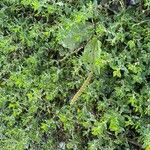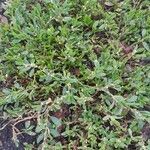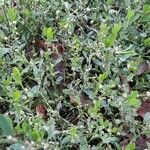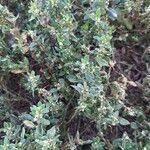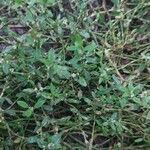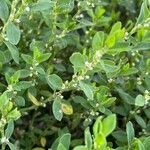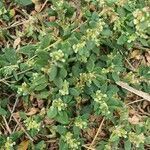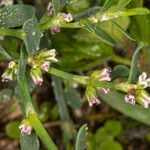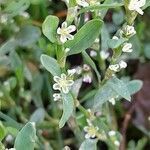Herbs annual. Stems procumbent or ascending, 15-30 cm tall, branched from base. Petiole short, articulate at base; leaf blade elliptic or oblanceolate, 0.5-2 cm × 2-5 mm, both surfaces with conspicuous veins, base narrowly cuneate, margin entire, apex usually obtuse; ocrea white, 2-3 mm, membranous, 5-7-veined, lacerate. Flowers 3-5, in axillary fascicles; bracts narrowly ovate, apex acute. Pedicel articulate at apex. Perianth green, 5-cleft to 1/2, veined, margin white; tepals oblong. Stamens 8; filaments dilated at base. Styles 3, very short; stigmas capitate. Achenes included in persistent perianth, dark brown, opaque, narrowly ovoid, trigonous, rarely biconvex, 2-2.5 mm, densely minutely granular striate. Fl. Jun-Aug, fr. Jul-Sep. 2n = 40, 60.
Freely branching, homophyllous annual, prostrate and commonly mat-forming; lvs bluish-green, broadly elliptic to oval-oblong, obtuse or rounded, 5–20 × 3–9 mm, often deciduous in late season; ocreae 3–6 mm, bifid, eventually lacerate; mature perianth 1.8–2.6 mm, divided to about the middle, the segments with white to pink margins and flat, obtuse or rounded tip; achenes 1.5–2.3 mm, shortly included to shortly exserted, dark brown, striate-papillate, late season ones to 4 mm, olivaceous, smooth; 2n=40. Abundant weed of dooryards, sidewalks, and streets, native of Europe, now widespread in temperate N. Amer. (P. aviculare, misapplied)
Nut dull but sometimes shiny on the edges, 2–2.5 mm long, trigonous, rarely lenticular, with 2 broad and convex sides and one narrower concave side, striate-punctate.
Perianth 1.5–2 × 2.5–3 mm, 5-lobed; lobes greenish with white or pinkish margins, at least twice as long as the perianth tube, flat and slightly imbricate.
Leaves all similar, subsessile, 5–15 × 2–6 mm, elliptic to elliptic-lanceolate, acute at the apex, attenuate to the base.
Flowers shortly pedicellate, in axillary fascicles of 2–4 flowers, surrounded by leafy bracts.
A glabrous, prostrate or ± decumbent, rarely erect, annual herb, forming dense mats.
Ocrea silvery at least in the upper part, 3–5 mm long, ferrugineous below, lacerate.
Stems up to 70 cm long, much branched, leafy, becoming somewhat woody at the base.
A herb. See Polygonym plebeium for Tasmanian reference by Curtis
Ovary 1–1.5 × 1.5–2 mm; styles 3, free, almost sessile.
Stamens 6, as long as the perianth; filaments filiform.
